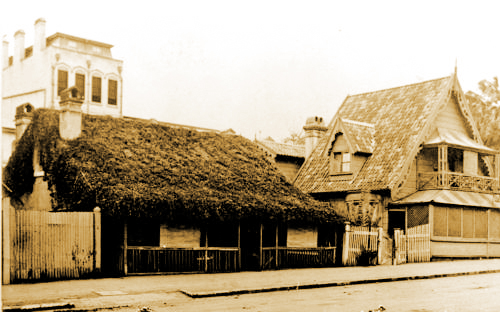The Circus Comes to Town
Several circus troupes were touring in the early days of the colony. The first company to visit what would become the Colony of Queensland, was La Rosiere's Travelling Circus which arrived by ship in the winter of 1855. Like most circuses of the day, the major act was a performance by female equestriennes.
Monsieur La Rosiere was actually Edward Hughes. As was the custom of
the day, he adopted a French stage name or nom
d'arena to sound foreign, exotic, and sophisticated.
The equestrienne, Mademoiselle La Rosiere, was 14 year old Jane Kendall,
the sister-in-law of Edward Hughes.
 |
| Young Somersaulting Equestrienne |
A circus usually set up next to a hotel, which provided accommodation
for the performers and stabling for the horses. The hotel would also provide
refreshments to circus goers before and after the performance, as well as
selling tickets.
The local press gave the circus performance a favourable review.
THE CIRCUS. - M. La Rosiere's troupe of equestrians have
been performing in Brisbane during several nights of this week, with general
success. A new entertainment has been introduced, in a little flirtation scene
between the clowns and the black horse, in which the latter has displayed great
sagacity and caused much amusement.
Master Loger's vaulting feats on horseback have been much
and deservedly applauded, and M. La Rosière's dislocating feats have caused
strong doubts whether she has any bones at all.
Mr. Ricardo is a very useful performer. He appears in as many
characters as Proteus. Some of the after pieces have caused much laughter, and,
in one, Mr. Barclay gave an amusing personification of a lubberly "hobbledehoy."
There is talk of varying the performances with a dramatic
entertainment, which would be judicious.[1]
 |
 |
| The North Australian, Ipswich and General Advertiser Tuesday 1 January 1856 |
At the end of the year, another company, the National Circus and
Hippodrome, arrived in Moreton Bay from Sydney on board the Boomerang which also brought news from
England of the victory at Sevastapol in the Crimean War.
The circus featured a
German band and some of the musicians took part in celebrations in Brisbane
Town with unfortunate consequences for one young player.
ACCIDENT WITH FIRE ARMS. - On Monday evening last, as a
young man named Johann Leinhardt, one of the German band of musicians brought
up by the Circus company, was firing a pistol near the ferry wharf, during the
general rejoicing on account of the victory at Sevastopol when the pistol
exploded, lacerating his hand in a terrible manner.
He was conveyed to the hospital where it was found that
one of the fingers was blown off, and the other had to be amputated.
This poor young man, quite a stranger in the colony, has
been maimed, and prevented from future pursuit of his musical career, by the
thoughtless but well-intentioned manifestation in his sympathy with the general
feeling, and his case seems well worthy of commiseration, and something more
substantial, from the inhabitants.[2]
 |
| Victorian Era Circus Equestrienne |
La Rosiere would bring his circus to Brisbane, Ipswich, and Warwick
several times over the following years. In 1857, the final performance of his
circus was put on at Ipswich, adjacent to the North Star Hotel.
At the age of just 33 years, Edward Hughes aka Monsieur La Rosiere,
died in a room at the hotel. The reason for his sudden death was not reported
but a family notice in the local newspaper recorded his passing.
DEATHS. Died at
Ipswich, on the 6th July, 1857, at the North Star Hotel, Mr. Edward La Rosiere
Hughes proprietor of circus, aged 88 [actually 33] years, lamented by his
beloved wife and relatives, and all who had known him.[3]
The circus was subsequently disbanded and some of the horses sold off
by auction.
SCOTT & Co. WILL sell by Public Auction, at the North
Star Hotel, THIS DAY, the 26th AUGUST, at 11 o'Clock,
A Splendid Grey
Mare, particularly well-adapted to the Saddle, having been one of the late Mr.
La Rosiere's stud. No reserve. Terms, Cash.[4]
Mademoiselle La Rosiere, aka Jane Kendall, would go on to have a long
career as an equestrienne, and circus owner. She would marry three times and had twelve
children, two of whom followed her into the circus.
 |
| Mademoiselle La Rosiere's daughter, the equestrienne Ida Vernon |
©
K. C. Sbeghen, 2013.
[1]
The Moreton Bay Courier Saturday 11
August 1855
[2]
The Moreton Bay Courier Saturday 22
December 1855
[3]
The North Australian, Ipswich and General Advertiser Tuesday 7 July 1857
[4]
The North Australian, Ipswich and General
Advertiser Tuesday 25 August 1857















